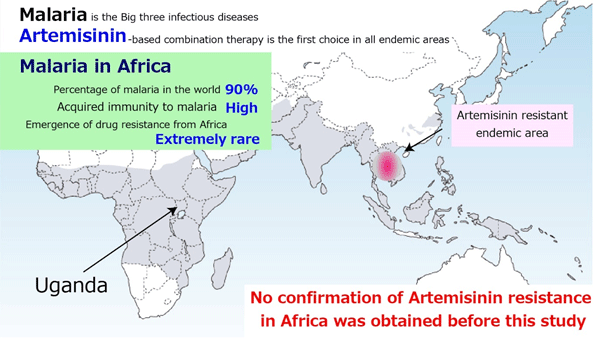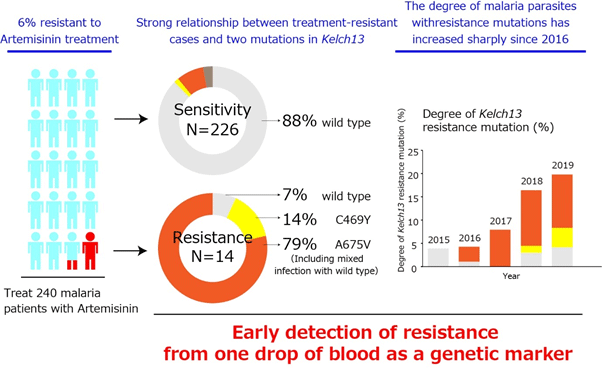Press Releases
23 September 2021
Juntendo University Corporate Communications
Juntendo University research
Emergence of malaria-drug resistance in Africa
(Tokyo, 22 September) Ninety percent of global malaria cases and deaths are reported in Africa. Researchers at Juntendo University report in the New England Journal of Medicine that mutants of the parasite causing malaria resistant to artemisinin, the prime drug for treating the disease, have emerged and are spreading in Africa. They also identify the genotypes responsible for the resistance, which will help to assist with its detection.
Malaria is widespread in the tropics and subtropics. In 2019, more than 200 million cases and more than 400 000 deaths related to the disease were reported. Malaria is caused by parasites of the Plasmodium group. The most common treatment involves the drug artemisinin, but during the last 10 years, P. falciparum parasites — causing most malaria deaths — resistant to artemisinin have emerged and spread in Southeast Asia. Also in Africa, artemisinin-resistant P. falciparum parasites have been discovered in recent years, posing a severe threat to malaria control. Now, Toshihiro Mita from Juntendo University and colleagues have performed a quantitative study of clinical artemisinin resistance of the parasite in northern Uganda and identified the parasite mutations associated with resistance.
The scientists worked with data collected from 2015 to 2019 at a hospital in Gulu, Uganda. They looked at the effect of treatment with an artemisinin drug (called artesunate) on more than 200 P. falciparum-infected patients. Patients were given three doses of the drug within 24 hours. Blood was regularly analyzed for traces of the parasite; these measurements enabled to estimate the parasite clearance half-life. A clearance half-life longer than 5 hours (meaning that more than half of the parasites were still surviving 5 hours after the initial dose of medication) was judged to signify in vivo artemisinin resistance. In most cases, parasites were quickly cleared, but 5.8% of cases showed resistance, which was furthermore found to be stable over the period 2017-2019.
The researchers also looked at the genotype (the relevant genetic information) of the parasites with which the patients were infected. Seven so-called kelch13 mutations were detected in 15.8% of cases, with two (labeled A675V and C469Y) being prevalent. The latter were found to be correlated with a longer clearance half-life, suggesting that they can be used as predictive markers of in vivo artemisinin resistance. Currently, A675V and C469Y are classified by the World Health Organization as candidate markers. The evidence of Mita and colleagues regarding A675V implies that its status should be updated to that of a proper molecular resistance marker.
Finally, comparing the Asian and African A675V mutants, the scientists were able to show that the two had different origins — in other words, artemisinin resistance emerged independently in Africa, not as the result of immigration. As a potential cause of the emergence of resistant mutants, the researchers suggest excessive use of injectable artesunate.
The results of Mita and colleagues clearly demonstrate the independent emergence of artemisinin-resistant P. falciparum in Africa, which, quoting the scientists, “poses a potential risk of cross-border spread across Africa, highlighting the need to perform large-scale surveys.”

Fig 1: What we knew about artemisinin-resistant malaria in Africa prior to this study

Fig 2:Evidence of artemisinin-resistant malaria in Africa revealed in this study
Background
Malaria
Malaria is a disease caused by microorganisms of the Plasmodium group. It is usually spread by an infected mosquito: a bite of the mosquito introduces the Plasmodium parasites into a person's blood. There are five species of Plasmodium that can infect humans, with most deaths caused by P. falciparum.
Malaria symptoms include fever, chills, headache, muscle aches, and tiredness. In addition, nausea, vomiting, and diarrhea may also occur, as well as anemia and jaundice (yellow coloring of the skin and eyes) because of red blood cell loss. Diagnosing malaria is usually done by the examination of blood.
The recommended malaria treatment is a combination of medications that almost always includes artemisinin. In areas where malaria is widespread, it is recommended to first confirm the disease before starting treatment because of concerns of developing drug resistance. Indeed, resistance to artemisinin is now well established in Southeast Asia. Now, Toshihiro Mita from Juntendo University and colleagues have confirmed artemisinin resistance in Africa too, with the resistance in Africa not being due to immigration but having emerged independently.
Artemisinin
Artemisinin and derived molecules are a group of drugs used for treating malaria caused by the parasite Plasmodium falciparum. Tu Youyou discovered artemisinin in 1972 and was awarded the Nobel Prize in Physiology or Medicine in 2015 for its discovery. Nowadays, therapies involving the administering of artemisinin are not only standard for curing P. falciparum malaria but also for malaria caused by other species from the Plasmodium group.
The advantage of artemisinin and its derivatives for treating malaria over other drugs is that they quickly kill all of a parasite’s life cycles.
Reference
Betty Balikagala, Naoyuki Fukuda,Mie Ikeda, Osbert T. Katuro, Shin-Ichiro Tachibana, Masato Yamauchi, Walter Opio, Sakurako Emoto, Denis A. Anywar, Eisaku Kimura, Nirianne M. Q. Palacpac, Emmanuel I. Odongo-Aginya, Martin Ogwang, Toshihiro Horii & Toshihiro Mita. Evidence of Artemisinin-Resistant Malaria in Africa. New England Journal of Medicine Vol. 385 No. 13 September 23 (2021).
DOI: 10.1056/NEJMoa2101746
URL: https://www.nejm.org/doi/full/10.1056/NEJMoa2101746
Further information
Juntendo University
2-1-1, Hongo, Bunkyo-ku, Tokyo 113-8421 JAPAN
E-mail:release@juntendo.ac.jp
Website:https://www.juntendo.ac.jp/english/
Research:https://www.juntendo.ac.jp/english/research.html
